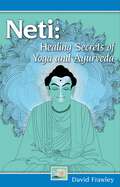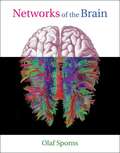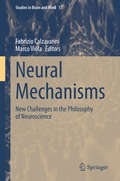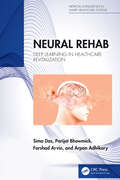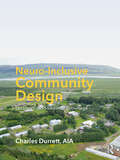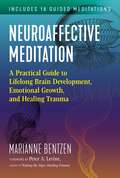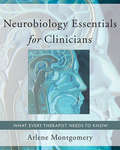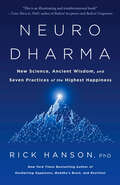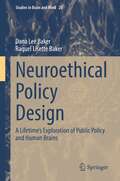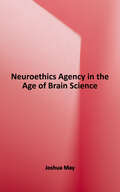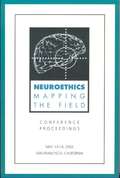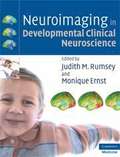- Table View
- List View
Neptune Princess
by Ingrid TomeyPoppy broke her leg and is sure the strange lady next door put a curse on her. She wants to enter the Neptune Carnival. Obtaining the goodwill of her neighbor may lift the curse.
Neris and India's Idiot-Proof Diet Cookbook
by India Knight Neris Thomas Bee RawlinsonIn Neris and India's Idiot-Proof Diet Cookbook India Knight and Neris Thomas enlist the help of Bee Rawlinson to create over a hundred low-carb recipes to help you get 'from pig to twig'.Low-carb cooking: a lot of meat with a side order of cream, right? Wrong. How about onion bhajias, sesame stir-fried duck and fabulously retro Black Forest Trifle for pudding? (Yes! Pudding!)Neris & India's Idiot-Proof Diet Cookbook is the least diety diet cookbook you've ever seen. Over a hundred quick-and-easy recipes (including some that need just five ingredients) cover every occasion. Each recipe fits perfectly into the Idiot-Proof Diet and will not only inspire and delight you, but - best of all - will make you shrink like you wouldn't believe.'The "Nigella of low-carb" . . . recipes you'll want to gorge on, whether you're following their low-carb plan or not' Scotland on Sunday'A practical and easy to follow collection of idiot-proof recipes that will inspire you to keep on track with your diet. You'll find recipes for breakfasts, snacks, soups, main meals, treats and desserts. Treat yourself' Easyfood'An easy-to-follow low-carb diet that doesn't mean eating meat three times a day' Woman & HomeIndia Knight is the author of four novels: My Life on a Plate, Don't You Want Me, Comfort and Joy and Mutton. Her non-fiction books include The Shops, the bestselling diet book Neris and India's Idiot-Proof Diet, the accompanying bestselling cookbook Neris and India's Idiot-Proof Diet Cookbook and The Thrift Book. India is a columnist for the Sunday Times and lives in London with her three children.Follow India on Twitter @indiaknight or on her blog at http://indiaknight.tumblr.com. Neris Thomas is a film producer and artist, she lives in London and is married with one daughter. Bee Rawlinson is a mother of four from Devon who came to Neris and India's attention through her delicious recipes on the Pig2Twig forum, the Diet's website.
Neris and India's Idiot-Proof Diet: A Weight-Loss Plan for Real Women
by India Knight Neris ThomasThis book tells you how two friends did it, and how you can do it too. It's not a diet devised by some bossy string bean who has never been more than 7 pounds overweight, nor by a fat middle-aged doctor, but a real, long-term, workable diet for real people. A modified and therefore bearable low-carb, high-protein way of eating, the diet really works and includes meal plans, recipes, advice on clothes, make-up and hair at every stage from fat to thin. It doesn't include impossible exercise routines or disgusting things to eat. Above all, it gets to the bottom of why we overeat--and shows you how to stop. There's never been a diet book like it--for women, by women, with jokes and useful tips, and advice that is truly simple to follow. What other diet book tells you to pour yourself a large drink at the end of the day, because you've earned it?
Neti: Healing Secrets of Yoga and Ayurveda
by David FrawleyThe most thorough and practical presentation of how to use the neti pot yet available. Notably the book shows the place of such 'nasal therapies' in India's great healing traditions and their broader relevance for treating common diseases.
Nettle Power: Forage, Feast & Nourish Yourself with This Remarkable Healing Plant
by Brigitte MarsA colorful, highly accessible guide to the healing and culinary uses of nettle, a protein-packed wild plant that is a favorite of foragers and herbalists.Nettle Power is a fascinating exploration of the many uses of nettle for food, medicine, and fiber. A plentiful wild plant with a long history of use by both European and Native American herbalists, nettle helps soothe skin conditions, strengthen bones, increase milk production in lactating mothers, restore the nervous system, purify the blood, and boost the immune system, among its many benefits. The plant's sting is easily neutralized by blanching and author Brigitte Mars shares a range of recipes for using the nutrient-dense green leaves as a tasty substitute for spinach or chard in salads, soups, and main dishes, along with healing recipes for teas, tinctures, juices, and elixirs. Colorful illustrations and curious facts and lore make this a highly browsable and useful handbook for foraging, herb, and natural health enthusiasts.
Nettoyage de Côlon Pour Perdre du Poids: meilleure santé, plus d'énergie et détoxification
by Kenneth BrownNettoyage de côlon pour perdre du poids : meilleure santé, plus d'énergie et détoxification De Kenneth Brown Présente des secrets professionnels utilisés pour se sentir en meilleure santé ! Souhaitez-vous éliminer l'inconfort, l'inflammation et la douleur ? Environ 80% de notre système immunitaire se trouve dans nos intestins, de nombreux maux d'aujourd'hui sont le résultat d'une mauvaise santé intestinale. Le nettoyage de votre côlon contribuera également à perdre du poids, à réduire les inflammations et à renforcer votre système immunitaire, vos niveaux d'énergie, votre concentration et à améliorer votre bien-être ! Vous vous sentirez mieux que jamais ! Grâce aux décennies de stratégies testées, cet ebook vous montrera le moyen le plus rapide et le plus efficace de nettoyer vos intestins ! Vous apprendrez comment augmenter votre bien-être en quelques semaines. Vous voulez savoir comment des personnes ayant pris beaucoup de poids, souffrant de maladies chroniques, de troubles de concentration et de douleurs ont pu augmenter leur bien-être naturel et éradiqué leurs maux ? Vous aussi, vous pouvez y parvenir, en suivant les conseils indiqués dans ce livre et vous pourrez enfin vous sentir mieux et être plus heureux.
Networks of the Brain
by Olaf SpornsOver the last decade, the study of complex networks has expanded across diverse scientific fields. Increasingly, science is concerned with the structure, behavior, and evolution of complex systems ranging from cells to ecosystems. Modern network approaches are beginning to reveal fundamental principles of brain architecture and function, and in Networks of the Brain, Olaf Sporns describes how the integrative nature of brain function can be illuminated from a complex network perspective. Highlighting the many emerging points of contact between neuroscience and network science, the book serves to introduce network theory to neuroscientists and neuroscience to those working on theoretical network models. Brain networks span the microscale of individual cells and synapses and the macroscale of cognitive systems and embodied cognition. Sporns emphasizes how networks connect levels of organization in the brain and how they link structure to function. In order to keep the book accessible and focused on the relevance to neuroscience of network approaches, he offers an informal and nonmathematical treatment of the subject. After describing the basic concepts of network theory and the fundamentals of brain connectivity, Sporns discusses how network approaches can reveal principles of brain architecture. He describes new links between network anatomy and function and investigates how networks shape complex brain dynamics and enable adaptive neural computation. The book documents the rapid pace of discovery and innovation while tracing the historical roots of the field. The study of brain connectivity has already opened new avenues of study in neuroscience. Networks of the Brain offers a synthesis of the sciences of complex networks and the brain that will be an essential foundation for future research.
Neural Machines: A Defense of Non-Representationalism in Cognitive Neuroscience (Studies in Brain and Mind #22)
by Matej KohárIn this book, Matej Kohar demonstrates how the new mechanistic account of explanation can be used to support a non-representationalist view of explanations in cognitive neuroscience, and therefore can bring new conceptual tools to the non-representationalist arsenal. Kohar focuses on the explanatory relevance of representational content in constitutive mechanistic explanations typical in cognitive neuroscience. The work significantly contributes to two areas of literature: 1) the debate between representationalism and non-representationalism, and 2) the literature on mechanistic explanation.Kohar begins with an introduction to the mechanistic theory of explanation, focusing on the analysis of mechanistic constitution as the basis of explanatory relevance in constitutive mechanistic explanation. He argues that any viable analysis of representational contents implies that content is not constitutively relevant to cognitive phenomena. The author also addresses objections against his argument and concludes with an examination of the consequences of his account for both traditional cognitive neuroscience and non-representationalist alternatives. This book is of interest to readers in philosophy of mind, cognitive science and neuroscience.
Neural Mechanisms: New Challenges in the Philosophy of Neuroscience (Studies in Brain and Mind #17)
by Fabrizio Calzavarini Marco ViolaThis volume brings together new papers advancing contemporary debates in foundational, conceptual, and methodological issues in cognitive neuroscience. The different perspectives presented in each chapter have previously been discussed between the authors, as the volume builds on the experience of Neural Mechanisms (NM) Online – webinar series on the philosophy of neuroscience organized by the editors of this volume. The contributed chapters pertain to five core areas in current philosophy of neuroscience. It surveys the novel forms of explanation (and prediction) developed in cognitive neuroscience, and looks at new concepts, methods and techniques used in the field. The book also highlights the metaphysical challenges raised by recent neuroscience and demonstrates the relation between neuroscience and mechanistic philosophy. Finally, the book dives into the issue of neural computations and representations. Assembling contributions from leading philosophers of neuroscience, this work draws upon the expertise of both established scholars and promising early career researchers.
Neural Rehab: Deep Learning in Healthcare Revitalization (Artificial Intelligence in Smart Healthcare Systems)
by Arpan Adhikary Sima Das Parijat Bhowmick Farshad ArvinIn recent years, the integration of cutting-edge technology with healthcare has led to groundbreaking advancements. Deep learning, in particular, has emerged as a revolutionary force, poised to transform the field of neural rehabilitation. This book sets the stage for the exploration of deep learning's significant impact on the revitalization of healthcare through neural rehabilitation.Neural Rehab: Deep Learning in Healthcare Revitalization offers a detailed exploration of the intersection between deep learning and neural rehabilitation, shedding light on a critical area in healthcare. Through real-life examples and case studies, readers will gain a practical understanding of how deep learning is utilized in everyday healthcare settings to improve patient outcomes. The focus is on how deep learning algorithms are being used to personalize rehabilitation plans, demonstrating how technology can tailor interventions to meet the unique needs and progress of each individual. The book covers various aspects of neural rehabilitation, such as stroke recovery, brain injuries, and neurological disorders, providing readers with a comprehensive understanding of the subject matter. A key emphasis is placed on the patient-centric approach, showcasing how deep learning contributes to enhanced patient experiences, improved recovery, and an overall better quality of life.This book is essential reading for healthcare professionals, researchers, and anyone interested in the intersection of deep learning and neural rehabilitation.
Neuro-Inclusive Community Design: Lessons from Sólheimar Ecovillage
by Charles DurrettThis book is an inspiring exploration of Sólheimar Ecovillage in Iceland, a pioneering community that embodies sustainability, social responsibility, and inclusivity.Cohousing expert Charles Durrett delves into the unique aspects of this ecovillage of about 100 residents, 45 of whom include those with developmental and intellectual disabilities, who live and thrive alongside neighbors in a safe and enriching environment. Through rich storytelling and detailed first-person accounts, the book highlights the importance of creating communities that celebrate and support neurodiversity. Durrett presents Sólheimar as a model for how we can build neuro-inclusive spaces that respect and uplift every individual’s potential, fostering a sense of belonging and purpose. The book offers practical insights into the design, the principles, and the practices that make Sólheimar a standout community for inclusive living. It challenges readers to rethink conventional approaches, advocating for environments where all people, regardless of their cognitive differences, can live meaningful and fulfilling lives. Durrett also presents case studies of four other neuro-inclusive communities, including Hertha Levefallesskab, WeBUILT (We Build Unique Independent Lives Together), Creative Living Community of CT, and L’Arche International Movement. With its focus on real-world solutions and its call to action, this book is both a guide and an inspiration for anyone interested in the intersection of sustainability, community living, and neuro-inclusivity.It will have a broad audience of architects, designers, occupational therapists, mental health professionals, housing developers, and practitioners in housing and social care, among others.
NeuroKinetic Therapy
by David WeinstockNeuroKinetic Therapy is based on the premise that when an injury has occurred, certain muscles shut down or become inhibited, forcing other muscles to become overworked. This compensation pattern can create pain or tightness. By applying light pressure that the client then resists, the practitioner can evaluate the strength or weakness of each muscle, revealing the sources of injury and retraining the client's body to remove the compensation patterns--reprogramming the body at the neural level.This easy-to-follow practitioner's manual presents a series of muscle tests specially designed to uncover and resolve compensation patterns in the body. Author David Weinstock begins by explaining how this approach stimulates the body and mind to resolve pain. Organized anatomically, each section of the book includes clear photographs demonstrating correct positioning of the muscle accompanied by concise explanations and instructions. Labeled anatomical illustrations appear at the end of each section showing the relationships between the muscles and muscle groups. This essential resource is especially useful for physical therapists, chiropractors, orthopedists, and massage therapists looking for new ways to treat underlying causes of pain.
Neuroaffective Meditation: A Practical Guide to Lifelong Brain Development, Emotional Growth, and Healing Trauma
by Marianne Bentzen• Shares 16 guided meditations for neuroaffective brain development and emotional maturation, along with links to online recordings • Explores the stages of emotional development, from childhood to old age, and their potentials for developing new ways of functioning • Reveals the biopsychological effects of meditation on the human brain, including how it affects us at the autonomic, limbic, and prefrontal levels Drawing on her 25 years of research into brain development as well as decades of meditation practice, psychotherapist Marianne Bentzen shows how neuroaffective meditation--the holistic integration of meditation, neuroscience, and psychology--can be used for personal growth and conscious maturation. She also explores how the practice can help address embedded traumas and allow access to the best perspectives of growing older while keeping the best psychological attitudes of being young--a hallmark of wisdom. She explains that there is a sequence to emotional maturation, just as there is for the development of cognitive or athletic skills, and details the central developmental processes of childhood and adolescence and the adult stages of psychological development. She then explores the biopsychological effects of meditation on the human brain, including how it affects us at the autonomic, limbic, and prefrontal levels. The author shares 16 guided meditations for neuroaffective brain development (along with links to online recordings), each designed to gently interact with the deep, unconscious layers of the brain and help you reconnect to yourself, your relationships, and the world around. Each meditation explores a different theme, from breathing in &“being in your body&” to feeling love, compassion, and gratitude in &“the songs of the heart&” to balancing positive and negative experiences in &“mandala.&” The author also shares a 5-part meditation centered on breathing exercises designed to balance your energy. Presenting an authentic, stepwise approach to spiritual growth, emotional maturation, and brain development, this guide explains the science behind neuroaffective meditation and offers detailed practices for a truly personal and ever-evolving experience of inner wisdom and growth.
Neurobehavioral Anatomy, Third Edition
by Christopher M. FilleyThoroughly revised and updated to reflect key advances in behavioral neurology, Neurobehavioral Anatomy, Third Edition is a clinically based account of the neuroanatomy of human behavior centered on a consideration of behavioral dysfunction caused by disorders of the brain. A concise introduction to brain-behavior relationships that enhances patient care and assists medical students, the book also serves as a handy reference to researchers, neuroscientists, psychiatrists, and geriatricians. The book outlines how cognitive and emotional functions are represented and organized in the brain to produce the behaviors regarded as uniquely human. It reviews the effects of focal and diffuse brain lesions, and from this analysis a conception of the normal operations of the healthy brain emerges. Christopher M. Filley integrates data and material from different disciplines to create a concise and accessible synthesis that informs the clinical understanding of brain-behavior relationships. Clinically practical and theoretically stimulating, the book is an invaluable resource for those involved in the clinical care and study of people with neurobehavioral disorders. Including a useful glossary and extensive references guiding users to further research, the third edition will be of significance to medical students, residents, fellows, practicing physicians, and the general reader interested in neurology.
Neurobiology Essentials for Clinicians: What Every Therapist Needs to Know
by Arlene Montgomery Allan N. SchoreThis book presents an overview of the latest theories of affect regulation and focuses on how these theories work in clinical settings and how therapists can be taught to implement them. The notion of teaching and learning will be extended by the theories themselves-the author presents methods of education that enact the theories being taught. The book is divided into eight chapters, each one highlighting a particular structure or related structures of the brain. Suggestions for learning how to clinically apply the neurobiological/neuroanatomical information are offered. What is so unique about this book is that the bulk of the chapters are clinical dialogue, accompanied by neurobiological commentary. Thus, readers can see for themselves, during the course of parts of sessions, just how a "neurobiological outlook" can inform therapeutic understandings of what clients are doing and saying. The result is a very user-friendly learning experience for readers, as they are taken along a journey of understanding various brain systems and how they relate to psychotherapeutic principles. Elegantly bridging the gap between the academic and clinical domains, this book is essential for anyone interested in the application of neurobiological principles to psychotherapy and wishes to learn about neurobiology without feeling overwhelmed or intimidated.
Neurocognitive Foundations of Mind (Routledge Studies in Contemporary Philosophy)
by Gualtiero PiccininiThis volume provides a cohesive and comprehensive case that cognitive neuroscience is maturing into an integrated, interdisciplinary science that is transforming our understanding of the mind.The rise of cognitive neuroscience has prompted a rethinking of levels, computation, representation, psychological explanation, and the relation between psychology and neuroscience. Despite these advances, many philosophers and scientists of the mind continue to write as though cognitive neuroscience didn’t exist and psychology remains autonomous from neuroscience or, perhaps, they maintain that cognitive neuroscience has not deepened our understanding of the mind. The chapters in this volume showcase important ways in which cognitive neuroscience makes a profound difference to our understanding of the mind. The contributors address a wide range of topics, including explanation, computation, representation, inference, emotion, language, intention, and thought. Together, they demonstrate the ways in which cognitive neuroscience supersedes traditional cognitive science and supports a unified, integrated, multilevel, mechanistic, neurocomputational account of the mind.Neurocognitive Foundations of Mind is essential reading for scholars and advanced students interested in the foundations of the philosophy of mind and the mind sciences.
Neurodharma: New Science, Ancient Wisdom, and Seven Practices of the Highest Happiness
by Rick Hanson PhDLOS ANGELES TIMES BESTSELLER • &“An easy-to-follow road map for creating day-to-day inner peace in today&’s increasingly complex world.&”—Lori Gottlieb, MFT, New York Times bestselling author of Maybe You Should Talk to SomeoneThroughout history, people have sought the heights of human potential—to become as wise and strong, happy and loving, as any person can ever be. And now recent science is revealing how these remarkable ways of being are based on equally remarkable changes in our own nervous system, making them more attainable than ever before. In Neurodharma, the follow-up to his classic Buddha&’s Brain, New York Times bestselling author Rick Hanson, PhD, not only explores the new neuroscience of awakening but also offers a bold yet plausible plan for reverse-engineering peak experiences, sense of oneness, and even enlightenment itself. And he does so with his trademark blend of solid science and warm encouragement, guiding you along this high-reaching path with good humor, accessible tools, and personal examples. A groundbreaking yet practical book, Neurodharma shares seven practices for strengthening the neural circuitry of profound contentment and inner peace—qualities that offer essential support in everyday life while also supporting the exploration of the most radical reaches of human consciousness. Step by step, this book explains how to apply these insights in order to cultivate unshakable presence of mind, a courageous heart, and serenity in a changing world. The breakthroughs of the great teachers are not reserved for the chosen few. Dr. Hanson shows how we can embody them ourselves in daily life to handle stress, heal old pain, feel at ease with others, and rest in the sense of our natural goodness. The Buddha didn&’t use an MRI to become enlightened. Still, 2,500 years after he walked the dusty roads of northern India, neuroscientists are discovering the mechanisms of the brain that underpin the Buddha&’s penetrating analysis of the mind. With deep research, stories, guided meditations, examples, and applications, Dr. Hanson offers a fascinating, inspiring vision of who we can be—and an effective path for fulfilling this wonderful possibility.
Neurodynamics
by Theodore Dimon G. David BrownNeurodynamics combines the latest discoveries in science, anatomy, and mindfulness to form a new understanding of human awareness in action. What good does it do to stretch, relax, or strengthen muscles if we don't know how these muscles are actually designed to function? To be sound, any physical therapy method must be based on scientific knowledge of how the musculoskeletal system works, on the role of proprioception in gaining awareness and control over this system, and on the process of becoming more conscious in action. Written for both beginning and advanced students, the book offers in-depth explanations of the theory of neurodynamics together with illustrations outlining steps of development and practical exercises. Over 100 years ago, F. Matthias Alexander made a series of discoveries about how the body works in action that made it possible for the first time to become conscious of what we're doing in activity. In Neurodynamics, author Theodore Dimon, who has taught and written about Alexander's work for many years, seeks to put together a coherent theory and curriculum for the Alexander Technique and explain how this system works in scientific terms. Neurodynamics develops and expands on Alexander's teachings and gives practical explanations that form the basis not just for a method but for a truly educational theory of how the mind and body work in action.
Neuroethical Policy Design: A Lifetime’s Exploration of Public Policy and Human Brains (Studies in Brain and Mind #20)
by Dana Lee Baker Raquel Lisette BakerThis volume focuses on the emergent field of neuroethics comparing and contrasting how two democracies, Canada and the United States, have begun adapting public policy design to better fit human minds. The book focuses on issues relevant to all members of the general population and discusses a series of policy issues arranged roughly in the order in which they become relevant in a typical person’s lifetime. After the introductory chapter each chapter considers an area of public policy particularly relevant to a different stage of life—from early childhood education policy, to policies for higher education and the workplace, to end of life decisions in living wills and advance directives. The author puts forth that making the shift towards more neurologically appropriate policy will likely be a gradual process hampered primarily by two issues. The first is the inability of neuroscientists to come to agreement on increasingly sophisticated research findings. The second issue points out that bringing policy and neurology into a more synchronous relationship requires a commitment to prolonged effort involves the largely unrecognized reality of entrenched neurological interests. The first chapter introduces the concept of disconnect between policy design with traditional understandings of the brain and goes on to highlight developments in the science of human neurology in recent years. To help contextualize the book, examples of neurological misperceptions are explored in this introductory chapter. Chapters Two through Eleven each explores a specific type of policy, incorporating understandings of the human brain which, modern neuroscience suggests, are debatable.
Neuroethics and Nonhuman Animals (Advances in Neuroethics)
by Andrew Fenton L. Syd M Johnson Adam ShriverThis edited volume represents a unique addition to the available literature on animal ethics, animal studies, and neuroethics. Its goal is to expand discussions on animal ethics and neuroethics by weaving together different threads: philosophy of mind and animal minds, neuroscientific study of animal minds, and animal ethics. Neuroethical questions concerning animals’ moral status, animal minds and consciousness, animal pain, and the adequacy of animal models for neuropsychiatric disease have long been topics of debate in philosophy and ethics, and more recently also in neuroscientific research. The book presents a transdisciplinary blend of voices, underscoring different perspectives on the broad questions of how neuroscience can contribute to our understanding of nonhuman minds, and on debates over the moral status of nonhuman animals. All chapters were written by outstanding scholars in philosophy, neuroscience, animal behavior, biology, neuroethics, and bioethics, and cover a range of issues and species/taxa. Given its scope, the book will appeal to scientists and students interested in the debate on animal ethics, while also offering an important resource for future researchers. Chapter 13 is available open access under a CC BY 4.0 license at link.springer.com.
Neuroethics: Agency in the Age of Brain Science
by Joshua MayIs free will an illusion? Is addiction a brain disease? Should we enhance our brains beyond normal? Neuroethics blends philosophical analysis with modern brain science to address these and other critical questions through captivating cases. The result is a nuanced view of human agency as surprisingly diverse and flexible. With a lively and accessible writing style, Neuroethics is an indispensable resource for students and scholars in both the sciences and humanities.
Neuroethics: Mapping the Field
by Steven J. MarcusThis volume contains the proceedings of a two-day multidisciplinary conference on the ethical implications of brain research organized by Stanford University and the University of California, San Francisco. Leaders in neuroscience, journalism, law, and philosophy, among other fields, engaged in a freewheeling debate on the social and individual effects of the research. Steven Marcus has edited their formal and informal deliberations to present a compelling first-hand account of the proceedings, providing a highly readable front-row seat about the first-ever symposium on neuroethics.
Neuroimaging in Developmental Clinical Neuroscience
by Judith M. Rumsey Monique Ernst Husseini K. ManjiModern neuroimaging offers tremendous opportunities for gaining insights into normative development and a wide array of developmental neuropsychiatric disorders. Focusing on ontogeny, this text covers basic processes involved in both healthy and atypical maturation, and also addresses the range of neuroimaging techniques most widely used for studying children. This book will enable you to understand normative structural and functional brain maturation and the mechanisms underlying basic developmental processes; become familiar with current knowledge and hypotheses concerning the neural bases of developmental neuropsychiatric disorders; and learn about neuroimaging techniques, including their unique strengths and limitations. Coverage includes normal developmental processes, atypical processing in developmental neuropsychiatric disorders, ethical issues, neuroimaging techniques and their integration with psychopharmacologic and molecular genetic research approaches, and future directions. This comprehensive volume is an essential resource for neurologists, neuropsychologists, psychiatrists, pediatricians, and radiologists concerned with normal development and developmental neuropsychiatric disorders.
Neuroimaging of Sleep and Sleep Disorders
by Michael J. Thorpy Eric Nofzinger Pierre MaquetThis up-to-date, superbly illustrated book is a practical guide to the effective use of neuroimaging in the patient with sleep disorders. There are detailed reviews of new neuroimaging techniques - including CT, MRI, advanced MR techniques, SPECT and PET - as well as image analysis methods, their roles and pitfalls. Neuroimaging of normal sleep and wake states is covered plus the role of neuroimaging in conjunction with tests of memory and how sleep influences memory consolidation. Each chapter carefully presents and analyzes the key findings in patients with sleep disorders indicating the clinical and imaging features of the various sleep disorders from clinical presentation to neuroimaging, aiding in establishing an accurate diagnosis. Written by neuroimaging experts from around the world, Neuroimaging of Sleep and Sleep Disorders is an invaluable resource for both researchers and clinicians including sleep specialists, neurologists, radiologists, psychiatrists, psychologists.



